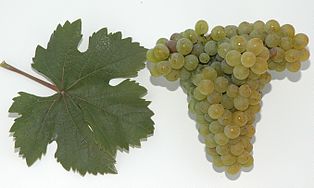Rotgipfler
| Rotgipfler | |
|---|---|
| Synonyms | Červenošpičák, Reifler, Rotreifler, Rotstreifler, Sladki Zelenac, Vöröshegyü, Zelen and Zelenac - for more see section synonyms |

|
|
| Art | Grape vine ( Vitis vinifera subsp. Vinifera ) |
| Berry color | greenish yellow |
| use | |
| origin | Austria, thermal region |
| VIVC no. | 10231 |
| ancestry | |
|
Cross of |
|
| List of grape varieties | |
The Rotgipfler is an autochthonous white wine variety from Austria, which today can only be found in the area around Gumpoldskirchen ( Thermenregion wine-growing region ).
Descent, origin
The Rotgipfler was first mentioned in Styria around 1837 by Johann Burger and is a natural cross of Traminer x Roter Veltliner . The Rotgipfler gets its name from the reddish shoot tips.
The variety came to Württemberg in 1850. Johann Philipp Bronner spread the variety in the Baden wine-growing region, from where it was brought to neighboring Alsace in 1874 .
This grape variety is related to Weißgipfler ( Grüner Veltliner ).
distribution
In Austria, a planted vineyard area of 197.5 ha was surveyed in 2015. Here it is almost exclusively distributed in the Thermenregion (Lower Austria) wine-growing region. There it is mainly used as a partner of the Zierfandler in the local special cuvée Spätrot-Rotgipfler.
Rotgipfler is also represented to a lesser extent in Germany (Baden, Württemberg), France (Alsace), as well as in Hungary, Croatia and Slovenia.
Ampelographic variety characteristics
- The shoot tip is open. It is very hairy with white wool and has a strong reddish color (hence the name Rotgipfer). The green young leaves are finely hairy and tinted bronze on the leaf edge.
- The shoot growth is erect but weak.
- The leaf is medium-sized, five-lobed with red veins, deeply lobed
- The grape is large, densely packed with greenish yellow, very juicy berries.
Maturity: late
Yield
The yields are high and regular.
Wine
When ripe, the wines are rich in extracts and have a pleasant acidity and a fine bouquet. The wines need a longer time to mature and are well suited for storage. Often the variety is blended with the Zierfandler (also called Spätrot) to the Spätrot-Rotgipfler (no separate variety name). In addition to the large quantities of Heurigen wines, the region is increasingly producing quality wines with great potential.
Claims, properties
The variety needs the best locations and, because of the weak shoot growth, medium-heavy and warm soils that are vigorous. Well tolerates calcareous soils. When the yields are high, it is cut down (decrease in shoot growth). The variety is susceptible to peronospora, botrytis and winter frost sensitive.
Synonyms
Synonyms 31: Červenošpičák, Červenošpičiak, Cimarossa, Crvenovršič, Grober Reifler, Grüner Reifler, Kutjevačka Zelenika, Kutjevački Zelenac, Rafler, Raifler, Rdeči Vrh, Reifler, Rotgipflelen, Slider, Slatflotter Rotler, Rothgipfler, Slider, Slipper, Rotler, Rotgipfler Bijeli Zelenac, Slatzki Zelenac, Stat Kizelemac, Statkizelenac, Vöröscsucsu, Vöröshegyi, Vöröshegyü, Vörösrangii, Weißer Reifler, Weißer Rotgipfler, Weißer Rothgipfler, Zelen.
Web links
- [1] , variety description of the Austrian Wine Marketing Society
literature
- Karl Bauer, Ferdinand Regner , Barbara Friedrich: Weinbau , avBuch im Cadmos Verlag, Vienna, 9th edition 2013, ISBN 978-3-7040-2284-4 .
- Ferdinand Regner , Karel Hanak, Cornelia Eisenheld: Directory of Austrian quality wine grape varieties and their clones , 2nd edition 2015, HBL and BA for WB, Klosterneuburg.
- Jancis Robinson : The Oxford Wine Lexicon. 3rd, completely revised edition. Hallwag, Munich 2007, ISBN 978-3-8338-0691-9 .
Individual evidence
- ^ A b c Karl Bauer, Ferdinand Regner , Barbara Friedrich: Weinbau , avBuch im Cadmos Verlag, Vienna, 9th edition 2013, ISBN 978-3-7040-2284-4 .
- ↑ Weingarten Baseline Survey 2015 Statistics Austria
- ↑ accessed on May 10, 2020 Rotgipfler in the database Vitis International Variety Catalog of the Institute for Grapevine Breeding Geilweilerhof (English)

